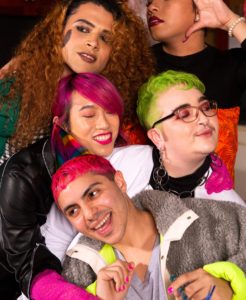 July 14th was International Non-binary People’s Day. As I checked posts out online, some of the stories made me think about how that can be reflected in my writing in the M/M genre, and in my reading and reviewing.
July 14th was International Non-binary People’s Day. As I checked posts out online, some of the stories made me think about how that can be reflected in my writing in the M/M genre, and in my reading and reviewing.
As I read gay romance, I’ve come across a few main characters whose gender may not be a simple “M”. Drag queens for example, may range from cis-male performance artists to a spectrum of fluid and bi-gender and other nonbinary identities. And increasingly, I see characters who may be assigned male (or female) at birth, but who clearly identify as nonbinary within the stories. Although those characters were usually written in relationships with cis-men, these stories sit on the edge of M/M with its assumption of genders.
If I shelve these books as M/M, when am I misgendering a character? Deciding that will take me paying better attention to the characters themselves. I recently read a book with a character who was almost certainly a trans woman (although being a historical, there was no safe space for her to be non-binary) — and I did note that in some reviews it been shelved as “gay romance” when it was about her and a cis man. If that made me wince, what does that do to a trans woman checking the reviews?
It made me realize that I didn’t have a shelf for M-enby-romance, and had likewise shelved several such books as m-m, disrespecting the gender identity of one of the characters. Books like Matthew J. Metzger’s Best Behavior where one MC eventually clearly identifies as agender (despite the sex involving two dicks) should be treated properly. I made the shelf and will try harder going forward.
Reading the opinion posts for Non-binary People’s Day also reminded me to check my biographies— cis folk like me can routinely include our pronouns in our bios and introductions to help normalize the idea that someone’s pronouns cannot be guessed by how they look or sound. Specifying ours also provides an opening for others to tell us their pronouns. I had already done this for some of my bios but had missed others.
I’ll try to make sure my future bios say ““Kaje” is pronounced just like “cage” – it’s an old nickname, and my pronouns are she/her/hers.” For nonbinary authors or readers, it may be risky to self-identify, but it’s safe for me and perhaps I can make it just a bit easier by having mine stated and not just assumed.
We can also be mindful as we write our books. I was reading a book yesterday where the MC runs an LGBTQ youth center, and a big deal was made out of how it had a floor for the girls and a floor for the boys and how that strictly determined how many kids they could serve. And my first reaction was how that lovely vision was cruel to non-binary kids, telling them there was no place for them in this safe haven. Unintentional, but hurtful. So as I write, I’ll be watching for my own unintended reinforcements of the gender binary.
In an ideal world, we would be making no assumptions about someone’s gender based on their appearance, ever. Since conforming can be a matter of safety, or money, that tall “man” with baggy board shorts and a wifebeater over their hairy chest may actually be a woman, or enby. In our writing, this would translate to our characters never assuming they saw a “man” get out of a car or a “woman” behind the coffee shop counter.
 I wrote a YA story once, about a cis-woman character from a future society where this was common courtesy. An enby sensitivity reader helped me see that I couldn’t write “She saw a tall woman across the room, standing by a severe-looking man.” I had to write something like “She saw a tall person with a silky gown clinging to their curves, next to another whose austere face looked cold and unwelcoming.” I had to write “monarch” not “king”, on “their” not “his” throne, and “youths” not “boys” running down the hallway. And “The bearded soldier in the doorway put their hand on the hilt of their weapon.” It was a fascinating education on just how often we assume gender, and how gendered our day to day language is.
I wrote a YA story once, about a cis-woman character from a future society where this was common courtesy. An enby sensitivity reader helped me see that I couldn’t write “She saw a tall woman across the room, standing by a severe-looking man.” I had to write something like “She saw a tall person with a silky gown clinging to their curves, next to another whose austere face looked cold and unwelcoming.” I had to write “monarch” not “king”, on “their” not “his” throne, and “youths” not “boys” running down the hallway. And “The bearded soldier in the doorway put their hand on the hilt of their weapon.” It was a fascinating education on just how often we assume gender, and how gendered our day to day language is.
I still don’t do that with most of my books. My characters don’t check their gender assumptions at the front page, because it doesn’t yet feel plausible in the characters I write. And I haven’t written another MC to whom that lack of assumptions would be natural. But awareness is a place to start, I guess. If you know of books that do this, I’d love to read some.
Like trans folk, non-binary people have been around forever, but actually respecting their place outside the traditional binary is relatively new (at least in Western culture.) For us cis folk, that means learning some new language (like a range of pronouns), new sensitivities, and doing some work to figure out how to be better allies going forward. I’m definitely still learning. One enby blogger made up a lighthearted but seriously intended list here: 100 Ways to Make the World Better for Non-Binary People” – https://www.vice.com/en_us/article/evkwm4/how-to-be-an-ally-to-non-binary-gender-non-conforming-people-support
If we want the books we read and write to have the most meaning, and for our genre to have a positive impact, then I believe we have to be open and supportive not just to a spectrum of sexuality and orientation, but also to what AC Dumlao calls the galaxy of gender. Readers don’t have to choose books about anything but two cis guys in love, but we should all know and respect that enby people are part of this community. (And if anything I said here needs correction or a change of tone please let me know. I’m definitely still in the learning process on how to be a better ally.)
– Kaje Harper
July 2019
First photo credit – The Gender Spectrum Collection: Stock Photos Beyond the Binary – taken by Zackary Drucker – https://broadlygenderphotos.vice.com/


Thank you, Kaje. I am exploring nonbinary and genderfluid characters in my romance writing now. I invented the hashtag #MXRomance because it is NOT MM and I know from my own nonbinary AMAB offspring that they are emphatically NOT a male.
I like that MX option. I’ll look forward to seeing what you do with the stories.